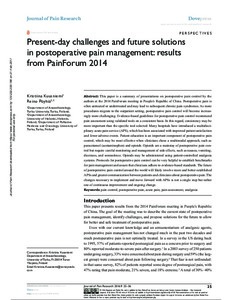Present-day challenges and future solutions in postoperative pain management: results from PainForum 2014
Kuusniemi K; Pöyhiä R
Present-day challenges and future solutions in postoperative pain management: results from PainForum 2014
Kuusniemi K
Pöyhiä R
DOVE MEDICAL PRESS LTD
Julkaisun pysyvä osoite on:
https://urn.fi/URN:NBN:fi-fe2021042716584
https://urn.fi/URN:NBN:fi-fe2021042716584
Tiivistelmä
This paper is a summary of presentations on postoperative pain control by the authors at the 2014 PainForum meeting in People's Republic of China. Postoperative pain is often untreated or undertreated and may lead to subsequent chronic pain syndromes. As more procedures migrate to the outpatient setting, postoperative pain control will become increasingly more challenging. Evidence-based guidelines for postoperative pain control recommend pain assessment using validated tools on a consistent basis. In this regard, consistency may be more important than the specific tool selected. Many hospitals have introduced a multidisciplinary acute pain service (APS), which has been associated with improved patient satisfaction and fewer adverse events. Patient education is an important component of postoperative pain control, which may be most effective when clinicians chose a multimodal approach, such as paracetamol (acetaminophen) and opioids. Opioids are a mainstay of postoperative pain control but require careful monitoring and management of side effects, such as nausea, vomiting, dizziness, and somnolence. Opioids may be administered using patient-controlled analgesia systems. Protocols for postoperative pain control can be very helpful to establish benchmarks for pain management and assure that clinicians adhere to evidence-based standards. The future of postoperative pain control around the world will likely involve more and better established APSs and greater communication between patients and clinicians about postoperative pain. The changes necessary to implement and move forward with APSs is not a single step but rather one of continuous improvement and ongoing change.
Kokoelmat
- Rinnakkaistallenteet [19218]
